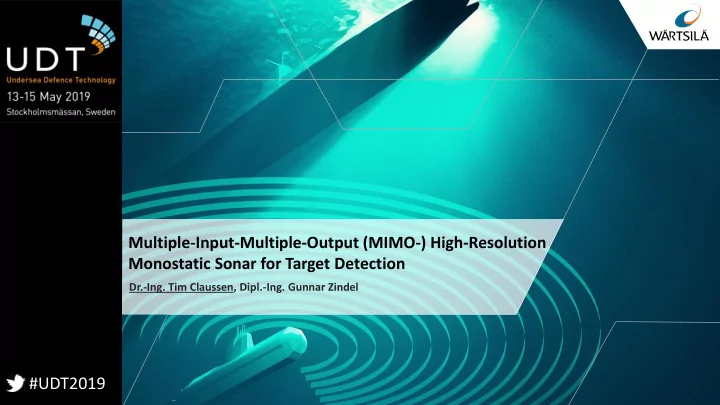

Multiple-Input-Multiple-Output (MIMO-) High-Resolution Monostatic Sonar for Target Detection Dr.-Ing. Tim Claussen, Dipl.-Ing. Gunnar Zindel #UDT2019
Motivation #UDT2019
Beamforming #UDT2019
Beamforming #UDT2019
Receive beamforming vs. Transmit beamforming Transmit beamforming: • Steering cannot be changed afterwards • Transmit direction is irrevocable imposed inside the receive signals #UDT2019
Beampattern • Important measure for the resolution of the beamformer #UDT2019
Beamformer performance modification • Goal: Decrease W and increase H #UDT2019
Beamformer performance modification • Possibility 1: Increase the amount of hydrophones to enlarge the aperture #UDT2019
Beamformer performance modification • Possibility 2: Increase the hydrophone spacing #UDT2019
The MIMO principle The typical active sonar system: • Single-input-multiple-output (SIMO) sonar • One coherent transmit signal (e.g. CW or FM) is transmitted Multiple-input-multiple-output (MIMO) sonar: • Transmits on every transmitter channel different signals • Orthogonal signal design #UDT2019
The MIMO principle The simples SIMO case: #UDT2019
The MIMO principle Two transmitter, one receiver: #UDT2019
The MIMO principle Transmitter side: • Independent, orthogonal signals • No transmission beam is formed Receiver side: • Divide the signals – matched filter – • “Re - cohere” the signals with ELAC Nautik’s MIMO Sonar technique • Prior knowledge • Restore orthogonality • Beamforming • Equivalent to SIMO #UDT2019
The MIMO principle #UDT2019
The MIMO principle #UDT2019
The MIMO principle #UDT2019
The MIMO principle #UDT2019
Conclusion • Subsequent transmit beamforming • Additional degree of freedom • Virtually enlarging aperture • Drastic increase of the spatial resolution #UDT2019
Recommend
More recommend